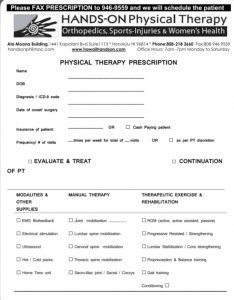PHYSICAL THERAPY PRESCRIPTION REQUIREMENTS
Are you interested in knowing physical therapy prescription requirements? If so, then you are on the right page. Feel relaxed and make sure you read the article to the end.

Numerous guidelines recommend physical therapy for the management of musculoskeletal conditions. However, specific recommendations are lacking concerning which exercises and adjunct modalities to use. Physical therapists use various techniques to reduce pain and improve mobility and flexibility. There is some evidence that specific exercises performed with the instruction of physical therapists improve outcomes in patients with low back pain. For most modalities, evidence of effectiveness is variable and controlled trials are lacking. Multiple modalities may be used to treat one clinical condition; decisions for the treatment of an individual patient depend on the expertise of the therapist, the equipment available, and the desire of the attending physician. A physical therapy prescription should include the diagnosis; type, frequency, and duration of the prescribed therapy; goals of therapy; and safety precautions.
Physical therapists are an integral part of inpatient and outpatient treatment of neurologic and musculoskeletal injuries and disabilities. They also can assist with and augment the care of patients with cardiac, pulmonary, and developmental disorders. Family physicians should have some understanding of the various treatments and modalities used by physical therapists.
Physical Therapy
Modalities are adjunctive treatments to exercise and manual therapy; the use of modalities alone is not considered physical therapy. The American Physical Therapy Association states: “Without documentation which justifies the necessity of the exclusive use of physical agents/modalities, the use of physical agents/modalities in the absence of other skilled therapeutic or educational interventions should not be considered physical therapy.”1 The ultimate goal of any physical therapy intervention is to improve the long-term function of the patient, which is best accomplished with the use of exercise, manual therapy, and modalities.
READ ALSO:HOW MUCH IS RIB REMOVAL SURGERY?
Research conducted during the development of several physical therapy modalities focused on how they affect inflammation. Many of the conditions that were thought to be inflammatory (e.g., patellar tendonitis) are in fact not histologically inflammatory. However, these tendinopathies (a more accurate classification) continue to be treated with modalities designed to decrease inflammation. There is some evidence that these modalities may be beneficial, but this may not be related to a true anti-inflammatory effect.
PHYSICAL THERAPY PRESCRIPTION REQUIREMENTS
It is a legal requirement that you have a prescription on file while seeing a licensed physical therapist in the United States. At what point you are required to obtain a prescription is determined by your insurance policy, and the direct access laws in your state. It is a legal requirement that you have a prescription on file while seeing a licensed physical therapist in the United States. At what point you are required to obtain a prescription is determined by your insurance policy, and the direct access laws in your state. I will only explain insurance policy here.
Insurance
If your insurance requires a prescription, you will need to have that prescription on file at the time of your first visit.
How do I know if I need a prescription?
- If you’d like to know whether your insurance requires a prescription right away, please call the member services line on your insurance card and ask whether your physical therapy benefits require a prescription.
- As a courtesy, we will verify your benefits approximately two days days before your evaluation, and send you an email with the details of your policy and whether a prescription is required
How do I get a prescription?
- To obtain a prescription, please schedule a visit with your primary care doctor, OBGYN, or other doctor familiar with what’s brought you to PT
- The prescription can be faxed to 310-479-2329 or info@theoriginway.com. You can also bring a physical copy in to your appointment.
Who can write a prescription?
- Medical Doctors (MD)
- Doctor of osteopathic medicine (DO)
- Podiatrists.
What should my prescription have on it?
Your prescription should include…
- At least two pieces of your identifying information (full name and date of birth are generally best)
- Orders from the doctor. We suggest the orders to be “evaluate and treat”, but the doctor can also provide a frequency and duration for care if they have something in mind (example: “treat 1x per week for 6 weeks”).
- The doctor’s signature, and date the order was signed.
If I’m a returning patient with an old prescription on file, do a need to get another one?
- Yes, if your insurance requires a prescription you will need to obtain a new prescription each time you’re coming back to Origin for a new evaluation.



